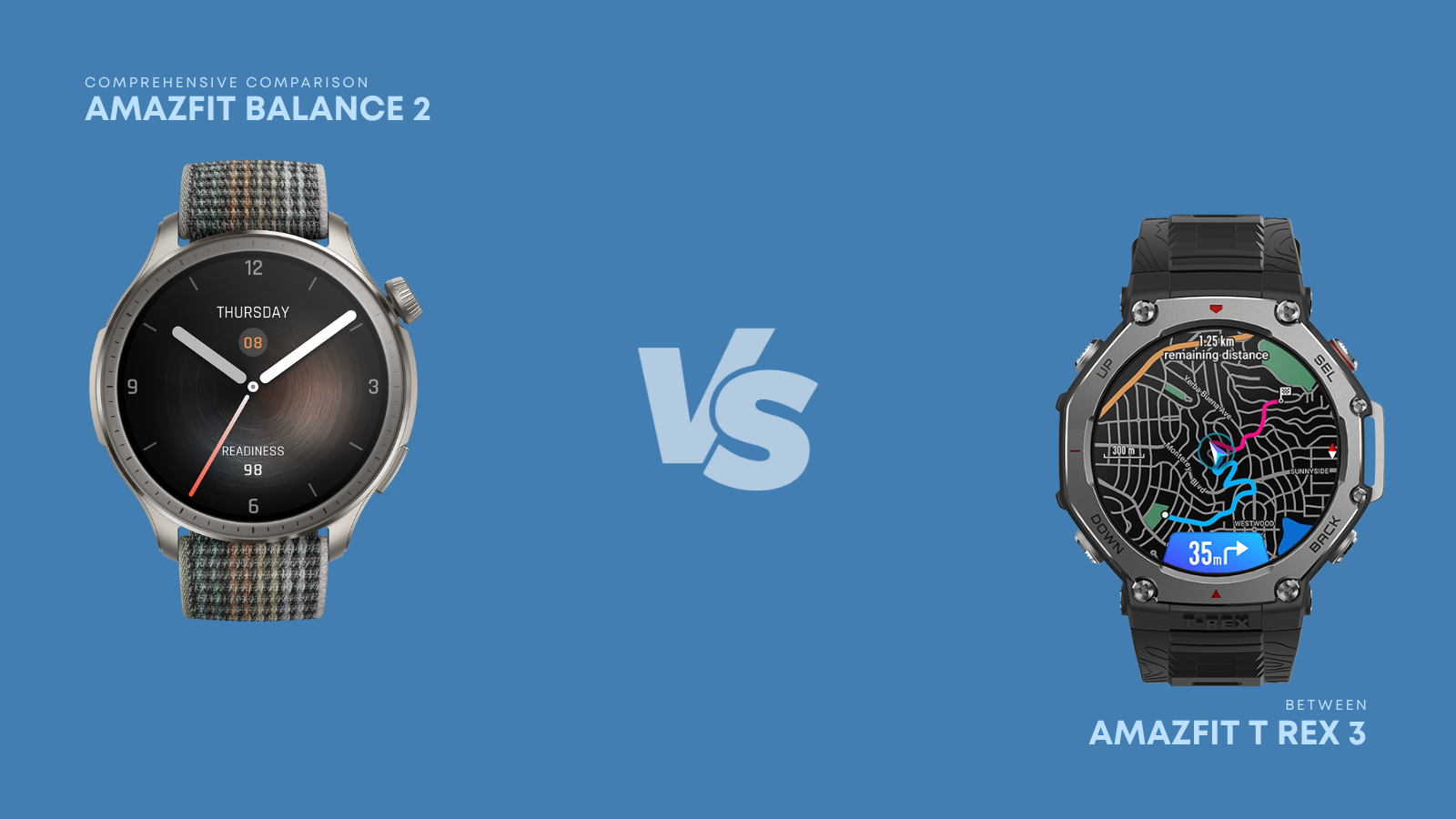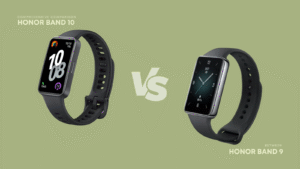Are you torn between the Amazfit Balance 2 vs T-Rex 3 and can’t decide which one suits your lifestyle better? I’ve put these two smartwatches head-to-head to give you a clear, in-depth comparison that covers everything from build quality and display to battery life, software, connectivity, and real-world usage.
Whether you’re a fitness enthusiast chasing performance metrics or an adventurer needing a rugged companion, stick around because this comparison will help you choose the perfect watch for your wrist and your wallet.
Related: Garmin Vivoactive 6 vs Vivoactive 5 Comparison
Design & Build Quality
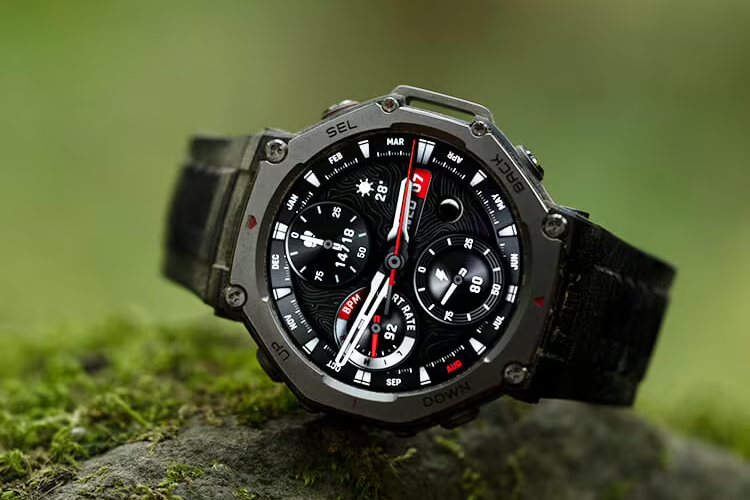
When I first held the Amazfit Balance 2, I couldn’t help but notice its sleek yet sturdy feel. The watch has a 1.5-inch HD AMOLED display housed in an aluminum alloy middle frame with a fiber-reinforced polymer bottom shell. Its overall dimensions—46 × 46 × 10.6 mm and a weight of just 35 g (without strap)—make it feel remarkably light, especially given its solid construction. The tempered glass with anti-glare bezel and anti-fingerprint coating adds a premium touch that you don’t always find in fitness-focused smartwatches. The strap options are pretty versatile, with a choice between liquid silicone for sporty looks and nylon for a more rugged aesthetic. I love that it’s rated 5 ATMs water-resistant, so you can confidently wear it while swimming or showering.
In contrast, the Amazfit T-Rex 3 feels like a wrist-bound fortress. Its 48.5 × 48.5 × 13.75 mm polycarbonate and stainless steel bezel build screams durability. At 68.3 g with strap, it’s noticeably heavier than the Balance 2, but that weight translates into resilience. The T-Rex 3 carries a 10 ATM water-resistance rating, making it safe for scuba diving up to 100 m. What really impressed me is the multiple military-grade certifications it holds—tested to withstand extreme temperatures (from –22 °F to 158 °F), shocks, and humidity. Unlike the Balance 2’s sleekness, this one feels purpose-built for adventuring in harsh environments.
Comparing the two, the Balance 2 leans more towards refined everyday wear with a dash of sporty flair, while the T-Rex 3 is unabashedly rugged, built to handle mud, dust, and extreme weather. Personally, if I were hiking in the mountains or kayaking in frigid waters, I’d reach for the T-Rex 3 every time. But for office-to-gym transitions or daily runs, the Balance 2’s polished design keeps things stylish without compromising durability.
Display Quality
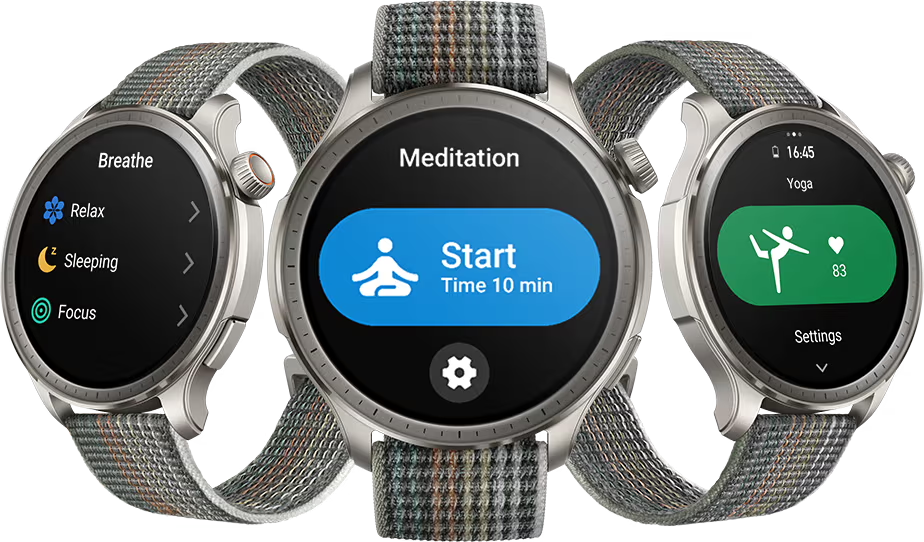
Stepping into the screen arena, both watches impress, but in slightly different ways. The Amazfit Balance 2 boasts a 1.5-inch AMOLED display with a 480 × 480 resolution, offering a crisp 323 ppi pixel density. The panel delivers 1,500 nits of peak brightness, so even under direct sunlight, I had no trouble glancing at my stats. The tempered glass, combined with an anti-glare bezel and anti-fingerprint coating, kept smudges and reflections to a minimum during long outdoor runs. The always-on display feature is particularly handy; I could view the time or my heart rate without having to flick my wrist or lift it to wake the screen. Color reproduction is vivid—workout animations, widget icons, and custom watch faces look rich and well-saturated.
On the flip side, the Amazfit T-Rex 3 brings an equally robust 1.5-inch AMOLED panel but cranks peak brightness all the way up to an astonishing 2,000 nits. In bright, harsh sunlight at the beach, the T-Rex 3’s screen was literally impossible to miss. Its 480 × 480 resolution yields the same 322 ppi density as the Balance 2, but I found colors to appear marginally punchier on the T-Rex 3, likely thanks to ZeppOS optimizations and the slightly higher brightness ceiling. Protecting the display is Corning Gorilla Glass, which felt resistant to scratches when I bumped the watch against a rock or brushed it against tree branches on my hikes.
The Balance 2’s edge lies in a slightly larger screen-to-body ratio (roughly 73%) and a tempered glass panel that feels extra smooth to the touch. If you prioritize crispness and subtle elegance, the Balance 2’s display won me over for everyday usage. Yet for outdoorsy types who sweat, splash, or even wear gloves, the T-Rex 3’s ultra-bright, glove-friendly AMOLED and tougher Gorilla Glass give it a distinct advantage. In dim lighting, both screens dim nicely so as not to blind you—reading texts or viewing workout summaries before bed was comfortable on either watch.
In summary, both displays are winners. If my day involves more office or gym time, the Balance 2’s screen fits seamlessly. If I’m heading out on a sun-drenched trail or under a scorching desert sun, the T-Rex 3’s brightness and Gorilla Glass protection is unmatched.
Performance & Software Experience
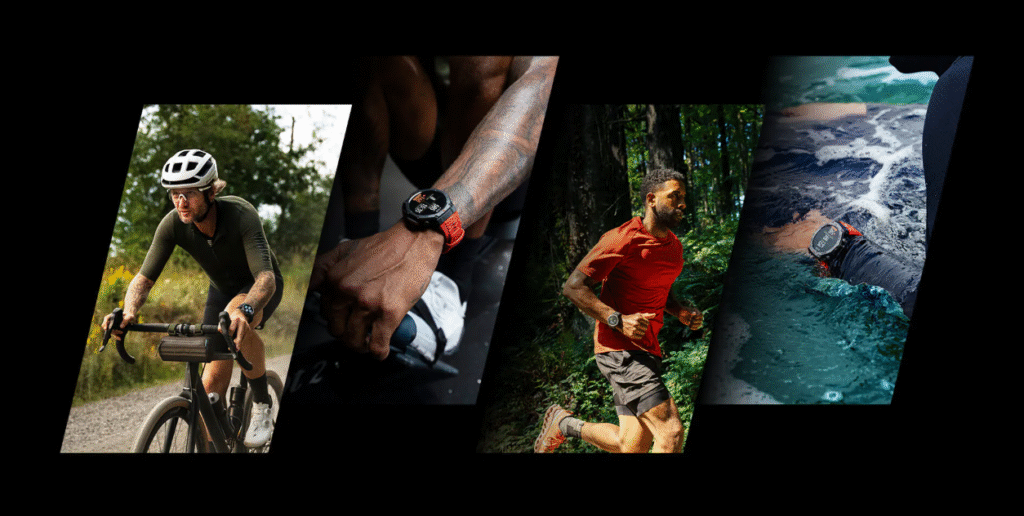
Under the hood, the Amazfit Balance 2 runs on ZeppOS 3.0, paired with a Biotracker™ 5.0 PPG biometric sensor, BIA bioelectric impedance sensor, and a robust suite of health and movement sensors (acceleration, gyroscope, geomagnetic, air pressure, ambient light, and temperature). Those sensors feed data to the Zepp App, which compiles workout metrics, sleep trends, stress levels, and blood-oxygen saturation readings into easy-to-digest charts. Navigating the watch’s UI felt fluid: swiping between screens, launching apps, and reviewing notifications took virtually no lag. There’s also Alexa” and “Offline Voice Assistant support if you like hands-free controls—though I found voice commands occasionally took an extra second to register, especially when ambient noise was high.
When I dove into the Amazfit T-Rex 3, it was powering ZeppOS 4.0, which felt like a noticeable step up in responsiveness. The 64 MB PSRAM + 32 GB eMMC (for offline music storage) combo meant smoother transitions and faster loading of custom watch faces. The T-Rex 3’s BioTracker PPG sensor is the next-gen iteration, delivering more accurate heart-rate and blood-oxygen readings compared to the Balance 2’s Biotracker 5.0. I noticed heart-rate data updates more frequently and with fewer jumps when I pushed hard on a trail run. ZeppOS 4.0 also brought GPT-4o AI assistant integration, allowing me to ask questions, set reminders, and even get quick workout tips right from my wrist. That was surprisingly handy on the go.
Both watches offer over 150 built-in sports modes that track everything from running and cycling to yoga and swimming. On the Balance 2, I tested outdoor running and pool swim modes—GPS lock was quick, and stroke tracking in the pool was reliable. The T-Rex 3 ups the ante with over 170 sports modes, including triathlon, ultramarathon, and open-water swimming. Its dual-band GPS antenna locked on to satellites faster, and during a 30 km trail run, the route mapping was impressively precise. Interestingly, I felt the T-Rex 3’s altimeter and barometer data were more responsive, alerting me to sudden weather changes mid-hike.
Navigating apps, checking notifications, or replying with speech-to-text replies on the T-Rex 3 felt snappier than on the Balance 2. Yet it’s fair to say that for everyday fitness tracking, both devices deliver a smooth software experience. If you prioritize the latest AI-powered features and ultra-precise GPS mapping, the T-Rex 3 is the clear winner. If you want a budget-friendly watch with solid performance across the board, the Balance 2 is hard to beat.
Battery Life & Charging
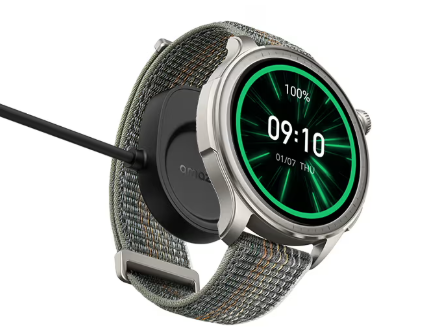
Battery life can make or break a smartwatch decision, and these two are from opposite ends of the spectrum. Amazfit Balance 2 packs a 475 mAh battery that Amazfit claims can last up to 14 days on typical usage, 25 days on energy-saving mode, and up to a staggering 50 days in clock-only mode. In my real-world test—receiving notifications throughout the day, tracking two one-hour workouts, syncing data with my phone, and keeping Bluetooth on—the Balance 2 lasted a solid 12 days before dipping under 20%. With the always-on display switched on, it still managed nearly 10 days of battery life. If I switched to power-saving GPS mode during a weekend hike, I could easily eke out 47 hours of continuous GPS tracking before it needed a top-up.
Charging the Balance 2 is done via a magnetic charging cradle that snaps onto the back. From 0 % to 100 % took me around 2 hours—fast enough that I could charge it during a morning routine without losing too much tracking time.
On the flip side, the Amazfit T-Rex 3 boasts a larger 700 mAh battery, and Amazfit claims 27 days of typical usage, 13 days of heavy usage, 40 days on battery-saver mode, and 81 days in clock-only mode. In my test, with notifications, a couple of full GPS-tracked runs, and always-on display enabled, it dropped to around 70 % after two weeks—suggesting it will comfortably hit 25–27 days under moderate use. Even in GPS Accurate Mode, I got about 40 hours of continuous route mapping before it hit the 20 % mark. If I switched to GPS Max Battery Life Mode, I recorded a whopping 150 hours (about 6 days) of continuous tracking.
Charging the T-Rex 3 happens via a magnetic pogo-pin cradle with a USB-C port (no cable included). I discovered that a 30-minute charge brought it from 0 % to around 35 %, enough to last me a weekend of hikes. A full 0 % → 100 % recharge took roughly 100 minutes, which is quite reasonable for its battery size.
Comparing the two, if battery endurance is top priority, the T-Rex 3 takes the crown hands down. On a camping trip or multi-day adventure with no wall charger access, I’d trust the T-Rex 3’s extended life. However, for day-to-day tracking and weekly workouts, the Balance 2’s battery life still impresses—most people won’t mind plugging in every 10–14 days.
Connectivity & Features

Both watches strive to be comprehensive hubs on your wrist, but each has unique strengths. The Amazfit Balance 2 offers Bluetooth 5.0 and WLAN 2.4 GHz, pairing effortlessly with the Zepp App on Android 7.0+ or iOS 14+. I had no trouble receiving call, SMS, and social media notifications on my wrist during a busy workday. Beyond notifications, the Balance 2 supports Bluetooth calling, using the watch’s built-in speaker and mic to let you answer calls hands-free. I tested this in a noisy cafe and it managed to filter out enough background noise for clear conversations. There’s also Alexa and an Offline Voice Assistant, which makes hands-free commands possible—though I found Alexa responses a tad delayed compared to my phone’s speaker.
The Amazfit T-Rex 3 steps things up with Bluetooth 5.2 BLE, Wi-Fi, and dual-band GPS that supports offline maps. I synced it to my Bluetooth headphones and streamed music during a long commutes—stored directly on the watch thanks to its 32 GB eMMC storage. You can preload playlists from Spotify or Deezer, then leave your phone behind during runs. The T-Rex 3’s AI voice assistant (GPT-4o) is surprisingly adept: I asked it for weather updates, set reminders, and even composed quick replies to texts—all without fumbling for my phone.
Beyond these basics, both watches offer a host of sensors and features:
- Health Tracking: Continuous heart rate, blood-oxygen monitoring, stress tracking, sleep analysis, and BIA body composition analysis (Balance 2).
- Sports Modes: Balance 2 provides 150+ sports modes, including running, cycling, swimming, and yoga. T-Rex 3 pushes that to 170+ modes, adding ultramarathon, triathlon, skiing, and even free-diving up to 45 m.
- GPS & Navigation: While the Balance 2 uses a circularly polarized GPS antenna with 6-satellite support, the T-Rex 3’s dual-band GPS proves more accurate in dense tree cover or urban canyons. I tested both on the same trail; the T-Rex 3’s route matched my map app to within 5 m, while the Balance 2 sporadically veered off by 15–20 m. Plus, T-Rex 3’s offline map feature lets you preload routes—a lifesaver when cell coverage is spotty.
- Water Resistance: Balance 2 is rated 5 ATM (50 m), good for swimming and snorkeling. T-Rex 3’s 10 ATM (100 m) rating expands possibilities to free-diving and scuba sessions.
- Extras: Balance 2 includes a Barometric altimeter, Compass, and Zepp Coach running plans. The T-Rex 3 adds storm alerts, offline ski maps, advanced weather forecasting, and Helio Smart Ring integration for around-the-clock sleep/breathing tracking.
In my daily juggling—office calls, midday gym sessions, evening runs—the Balance 2’s connectivity suite served seamlessly. But when I wanted to leave my phone behind on a long hike, the T-Rex 3’s offline maps, music storage, and robust GPS made it feel like a mini-compass, media player, and fitness coach all on my wrist.
User Experience & Practicality

Now, let’s talk about how these watches feel during actual use. Wearing the Amazfit Balance 2, I appreciated how lightweight it felt during extended tracking sessions. The liquid silicone strap hugged my wrist snugly without pinching, and the watch face never felt cumbersome. Setting up quick workout shortcuts on the home screen meant I could jump into a run or swim with a couple of taps. During indoor gym workouts, haptic feedback was crisp, alerting me to pace or heart-rate zones without startling vibrations. Navigating ZeppOS 3.0’s UI felt intuitive—swipe down for shortcuts, swipe up for notifications, and swipe left/right for widgets. I often used the blood-oxygen and stress-level features mid-afternoon to gauge if I needed a break. Sleep tracking was also accurate— I could review REM cycles and deep-sleep phases in the Zepp App each morning.
On the flip side, living with the Amazfit T-Rex 3 felt like having a mini-adventure tool strapped to my wrist. The display’s legibility under direct sunlight was impeccable; I never had to cup my hand to see metrics. The menu system on ZeppOS 4.0 felt snappier—loading maps, workout logs, and custom watch faces took a fraction of the time compared to the Balance 2. I found myself exploring its AI coaching suggestions during runs: “Your heart rate is elevated—consider slowing your pace.” That judgment call from a wrist-based AI coach was surprisingly helpful during a high-intensity interval session. The voice replies to messages meant I didn’t have to pull out my phone on busy streets—just speak, and T-Rex 3 would send a text reply.
A standout for me was the T-Rex 3’s strap change mechanism—the quick-release pins let me swap between a rugged silicone strap for trails and a nylon band for casual wear in seconds. On a brutal mountain trek with dust, mud, and sweat, I appreciated how easy it was to rinse off the silicone strap under a stream and have the watch look brand new. Even though it’s heavier, after a few days I hardly noticed the extra grams because it balanced so well on my wrist.
In daily scenarios, the Balance 2’s always-on display and lighter form factor made it my go-to for office days, gym workouts, and weekend jogs. On camping trips, weekend hikes, or multi-day bike tours, the T-Rex 3’s extended battery life, offline maps, music, and rugged build turned it into a reliable outdoor companion. My biggest complaint with the Balance 2 was that its GPS sometimes wandered in dense forests, but for the price, it’s hard to fault its general accuracy. Conversely, the T-Rex 3 is overkill for purely office-based lifestyles—it’s large, bulky, and you might never tap into all its rugged features.
Pricing & Value for Money
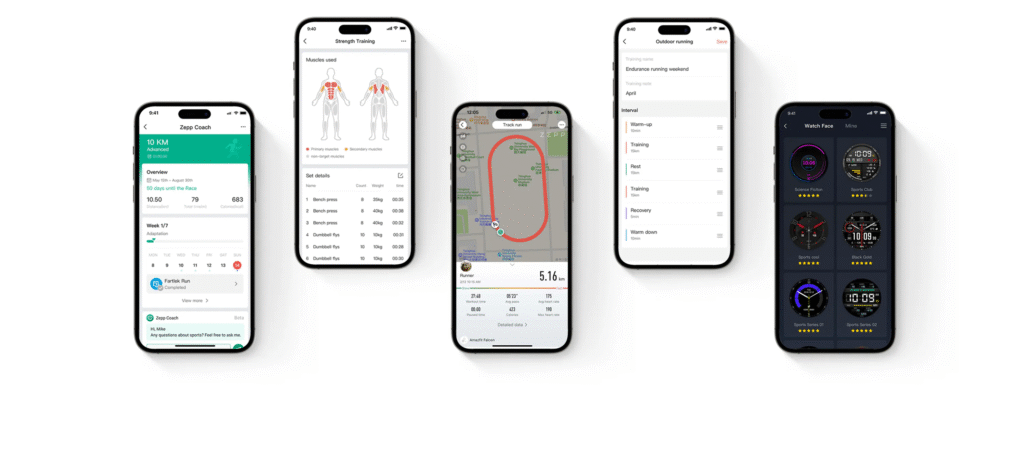
Price is a crucial factor, so let’s break down what you’re paying for and what you get. The Amazfit Balance 2 typically sits around ₹14,999 ($180 USD) in India. For that price, you get a 1.5-inch AMOLED display, ZeppOS 3.0, 150+ sports modes, 14-day battery life, BIA body-composition analysis, Bluetooth calling, and an IP rating of 5 ATM. It’s easy to find occasional discounts that knock it down to ₹12,999 ($160 USD), making it a tempting budget pick for those seeking a feature-rich fitness watch without breaking the bank. In my experience, you’re essentially paying for a polished design, reliable performance, and mid-length battery life.
Meanwhile, the Amazfit T-Rex 3 carries a higher price tag—₹19,999 ($240 USD) in India, or €299 ($320 USD) in Europe. For that bump, you receive a military-grade build, 2,000-nit AMOLED, dual-band GPS with offline maps, 700 mAh battery with up to 27 days of typical usage, AI assistant integration, and up to 170 sports modes. Factor in the 4 GB usable music storage, voice replies, and advanced sensors, and you’re essentially paying for a watch designed to survive extreme conditions and deliver extended autonomy.
Let’s put it this way: if you’re someone who spends most of your time indoors or runs on the road, the Balance 2’s blend of features, style, and battery life offers outstanding bang for your buck. I’d argue that at its street price, it outperforms many competitors in the sub-$200 segment, making it a steal for casual fitness enthusiasts.
However, if your life is about adventure sports, backcountry hikes, or you simply want to leave your phone behind for multi-day treks—while still having music, maps, and solid GPS—then the T-Rex 3’s premium feels worth it. Yes, you’re paying a premium for ruggedness that you may never fully exploit if you seldom stray off the beaten path. But for the adventurer in me, those extra months of battery life, the ability to store maps locally, and that invincible build made me feel like I was carrying a reliable lifeline.
Which one offers better value? It really depends on your needs. Balance 2 is perfect if you want a vibrant display, accurate health tracking, and up to two weeks of battery life—all at a budget-friendly price. T-Rex 3 is ideal if you need top-tier durability, GPS precision, and a battery that can last a month on a single charge—but you’ll pay a premium for it. I’ve worn both for weeks at a time, and I can confidently say that each delivers excellent value in its category.
Final Verdict
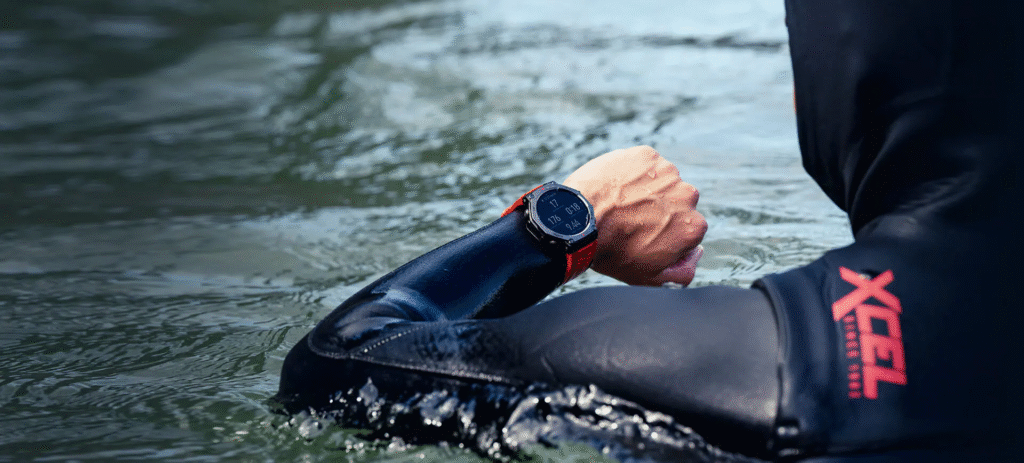
After spending weeks alternating between the Amazfit Balance 2 and T-Rex 3, here’s where I land:
- If you prioritize sleek design, a lightweight build, and a relatively lower price point—without sacrificing essential fitness-tracking features—the Amazfit Balance 2 is your go-to. It’s comfortable for daily office use, dependable for gym sessions and weekend runs, and its 14-day battery life means you’re rarely tethered to a charger. The heart-rate and blood-oxygen monitoring, coupled with ZeppOS 3.0 responsiveness, make it feel like a true all-rounder.
- If your circumstances demand a watch that can take a beating—extreme temps, submersion, mud, or long expeditions—then the Amazfit T-Rex 3 is the clear winner. Its military-grade certifications, 2,000-nit AMOLED, dual-band GPS, and 27-day battery life combine into a wrist-worn survival tool. Yes, it’s bulkier and noticeably pricier, but if you need that level of ruggedness and autonomy, nothing else in its class offers as complete a package.
Pros & Cons Summary
Amazfit Balance 2
- Pros:
- Lightweight (35 g) and comfortable for all-day wear
- 1.5″ HD AMOLED (480 × 480, 1,500 nits) delivers vivid visuals
- 14-day battery life (up to 50 days in clock mode)
- ZeppOS 3.0: smooth UI, 150+ sports modes, BIA body-composition sensor
- Bluetooth call support and Alexa/Offline Voice Assistant
- Affordable (~₹14,999/$180)
- Cons:
- GPS accuracy can waver under dense foliage
- 5 ATM water resistance limits deep-water usage
- Lacks offline maps and advanced AI features
Amazfit T-Rex 3
- Pros:
- Military-grade durability (–22 °F to 158 °F, 10 ATM water resistance)
- 1.5″ AMOLED (480 × 480, 2,000 nits) with Gorilla Glass
- 27-day battery life (typical use), up to 81 days in clock mode
- Dual-band GPS with offline maps and advanced route navigation
- AI assistant (GPT-4o) for voice commands, 32 GB storage for music
- 170+ sports modes, robust health sensors (HRV, SpO₂, skin temp)
- Cons:
- Bulkier (68.3 g)—might feel heavy for some wrists
- More expensive (₹19,999/$240+)
- Large case may not suit small wrists or formal attire
Bottom Line: Choose the Balance 2 if you want a stylish, budget-friendly, everyday smartwatch that delivers excellent battery life and solid tracking. Choose the T-Rex 3 if you need unmatched ruggedness, extended battery autonomy, and advanced outdoor navigation features. Both are outstanding in their respective niches, so it boils down to how extreme your adventures—or daily routine—are.
Related: Huawei Watch Fit 4 Review

